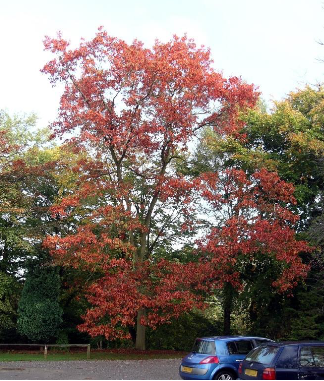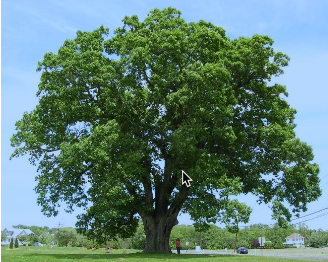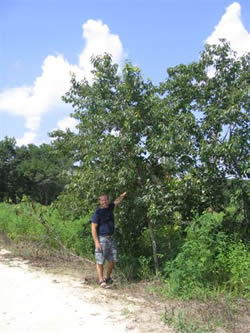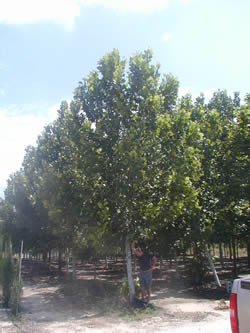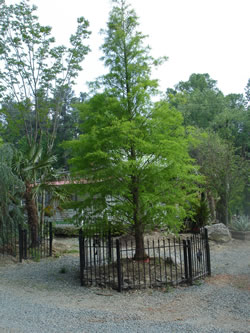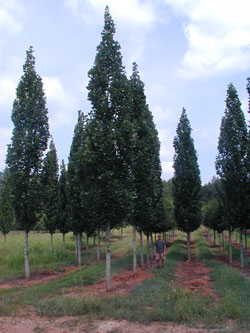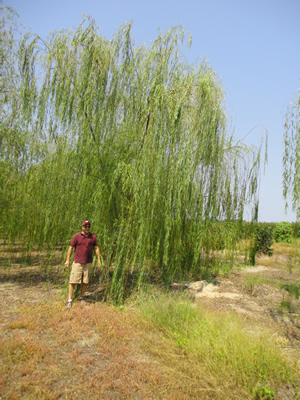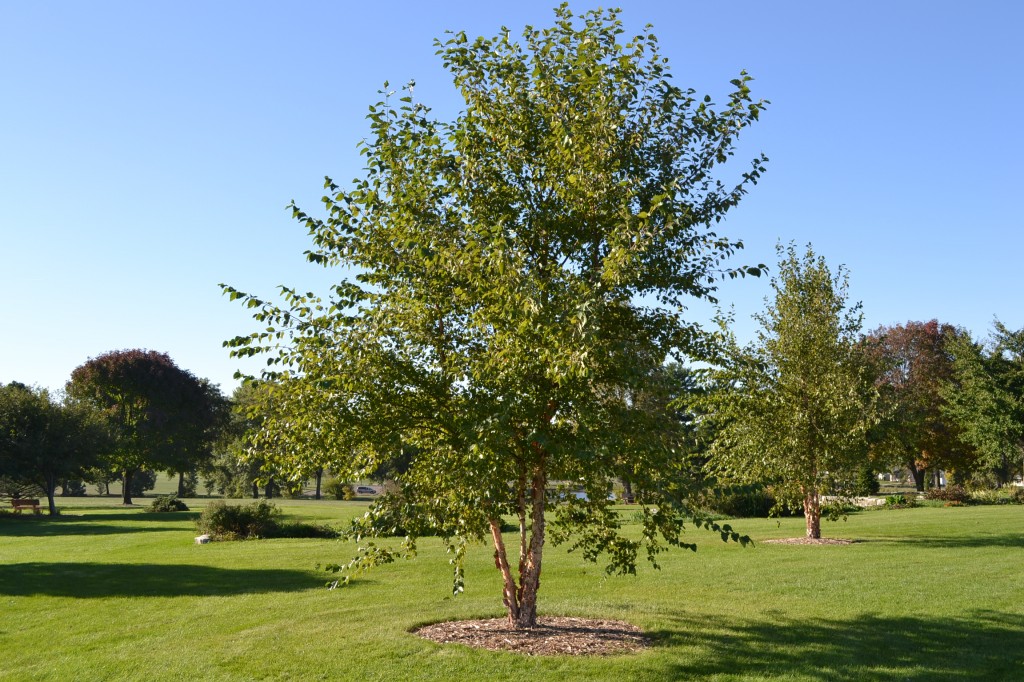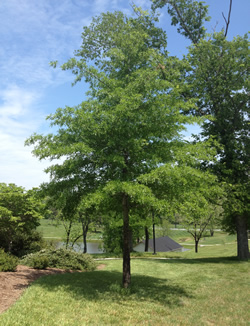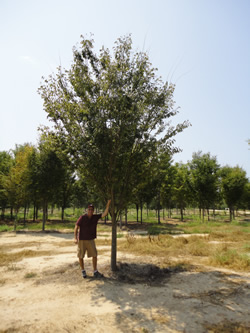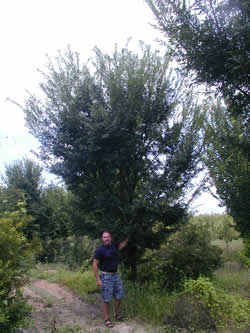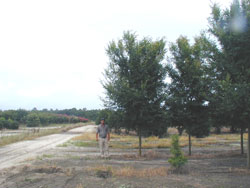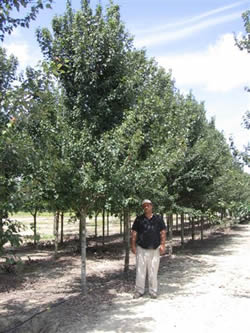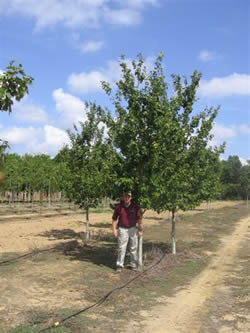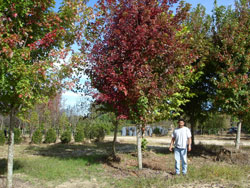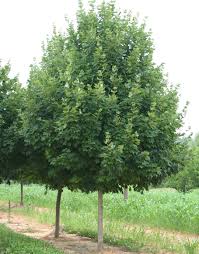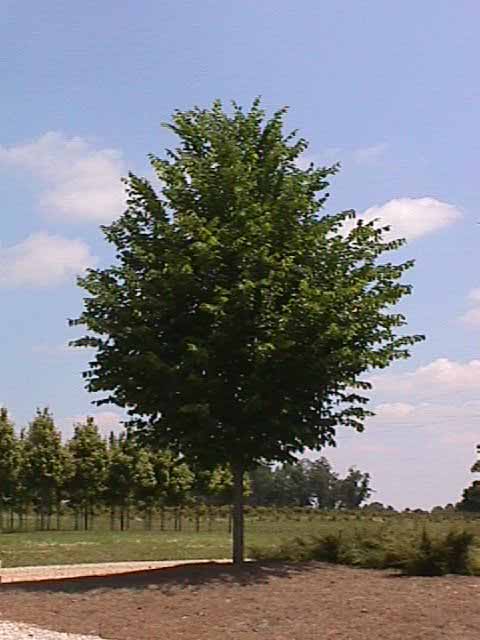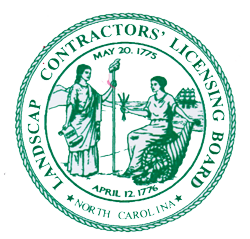Many homeowners suddenly find themselves in need of instant shade sometimes from the loss of an older established tree or from moving into a new home where all the trees were removed. Home and Garden Landscapes has many years of providing homeowners with instant shade solutions with larger trees suited to their specific set of circumstances. Whether its using the fast-growing Princeton American Elm or cultivars of Red Maple which provide brilliant fall color, we have a solution. Some of our larger trees are available in sizes up to about 28 feet and with an initial trunk caliper of 6″ or more.
Click to Download the Care Sheet
This easy grower gets up to 80 feet tall at maturity and tolerates poor soil conditions. Red Oaks are long-lived like most oaks and prefer acidic soil that is on the dry side. Showy leaves are dark green on top and contrasted with a downy tan coating on the bottom. They don’t need much pruning but if necessary, trim them in late winter or early spring. When established, Red Oaks are drought tolerant. Their acorns take two years to mature and drop and are valued by wildlife.
White Oaks are slow growers, but at maturity reach a stately 50-100 feet tall with an equal spread. They thrive in lawn settings as long as they have adequate space in sun or partial shade. Like other oaks, they prefer acidic soil that is moist, but well-drained, but will adapt to most soil conditions and are moderately drought tolerant. They work best planted away from sidewalks and driveways as their trunks flare out at the bottom. They should be pruned in the winter or early spring before they leaf out. White Oaks also drop acorns after maturity, which wildlife loves.
American Persimmon is a native fruiting tree of the Eastern US. Valued for its tasty fruit, beautiful bark and unique growth habit, it is increasingly being used in landscapes. The biggest limiting factor is availability. Home and Garden Landscapes has sources for larger trees and recommends this tree for consideration.
Bald Cypress, long associated with the swamps of the Southeastern US is a beauty well suited for landscape incorporation. It can literally grow in conditions from having it’s root system submerged in water to dry locations in the landscape. Some cultivars are also absent the “kneeing” most associated with this tree.
Being a “coniferous evergreen” puts this tree in a class few other trees inhabit. This means it’s an evergreen which loses it’s foliage in the Fall. Spring color is a brilliant lime green and fall foliage is a gorgeous copper color sure to add pop to any landscape. We highly recommend you consider this plant if you have room.
With a movement towards native trees, this fast-growing native is increasingly being used in landscapes. As it’s name implies, it has flowers in the Spring that are somewhat reminiscent of tulips. These are highly prized by honey bees making it a favorite of bee keepers. The trees rapid growth, tolerance for dry as well as soggier soil conditions make it a good choice for areas needing rapidly growing trees.
Trees should not be planted near structures as their rapid growth translates into weaker branching and wood. This lends susceptibility to wind and ice storm damage.
Weeping Willow is one of our favorites if you have the right environment and enough room. It is very tolerant of soggy soils as well as dryer placements. Very rapid growth and its beautiful weeping nature make Weeping Willow one of the widest used trees in landscaping.
Weeping Willow is one of the first indicators of Spring with its leaves starting to peep out long before other trees have broken dormancy. It’s yellow foliage in fall add another positive for this beauty in the landscape.
Limiting factors include a highly invasive root system which means placing it near septic lines or masonry a no-go. With its rapid growth, it also is relatively short-lived and has weaker branching lending susceptibility to ice-storm damage.
River Birch is a native of Eastern North America and is extensively used in the landscape. As one of the few trees with a tolerance for soggy soil conditions as well as dry placement, this allows for a large range of use in landscaping.
Trees are very fast growing and have a coppery-brown coloration to the bark. Extreme heat can cause premature leaf drop in late Summer but some cultivars such as Dura-Heat River Birch lessen this problem.
This tree should be given plenty of room and not planted near foundations, masonry or the house where its invasive root system can cause issues. It is also susceptible to ice storm damage and should not be planted where it can fall on structures. However, if you have the room, this is a great fast-growing shade and/or ornamental choice for the landscape.
Willow Oak, sometimes erroneously called Pin Oak in the Southeast is a southeastern native and is widely used in landscapes in the southern US. It has one of the fastest growth rates for an oak and is extremely drought and heat tolerant once established.
Willow Oak requires relocation during its dormant period and provides beautiful yellow fall foliage.
Green Vase Zelkova is a great shade tree choice for today’s landscapes. A very popular tree in Asia which was brought to North America to replace the American Elm, Zelkova is treasured for its vase shape and beautiful fall foliage. Tree trunks are smoother and lighter in coloration adding another attribute.
Allee Elm, a variety of Chinese Elm, is frequently used to create avenue or alleyways. A fast grower that is very hardy once established does well in southern heat. The only negative is a tendency to be damaged during heavy ice storms and/or heavy wet snows due to it’s weaker branching structure.
Autumn Blaze Red Maple is widely used in landscapes all over the country. With its fast growth, uniform shape and incredibly beautiful fall foliage, it is a valued landscape plant. It’s primary use for gardens and landscapes is for shade and fall color.
The Red Sunset cultivar of the common Red Maple is widely used as a shade tree and in commercial and residential landscapes. It has a somewhat looser form than the October Glory and Autumn Blaze cultivars but not as loose as the purely native form native to most of Eastern North America. It is valued for fast-growth, drought tolerance and beautiful fall foliage.
The October Glory Red Maple is perhaps our favorite cultivar of the Red Maples. It’s uniform shape (not unlike that of a Sugar Maple), fast growth and beautiful fall foliage make it a favorite for shade in the landscape. It has been widely planted throughout the US and is quite tolerant of heat and drought once established.
Home and Garden Landscapes have installed this trouble-free cultivar in hundreds of landscapes over the years and recommends this tree highly.
Sugar Maple, an iconic favorite of landscapes the world over is valued for its uniform shape, breathtaking fall foliage and in some regions for its sugar production. Native from Canada into the southeast Sugar Maples can be successfully grown in southern landscapes. They do have some susceptibility to ice storm damage in areas where this is a factor.
Considered by many to be the premier landscape and shade tree in North America, the nation’s Elm populations were decimated by the introduction of Dutch Elm Disease in the 1920s. Many towns and cities in America had Elms that were over 100 years old and formed the backbone of the urban landscape. Many cities, particularly in the Midwest, lost 90% of their landscape and city street trees as this species was so widely planted.
A few years back it was discovered that the American Elms planted by Princeton Nursery in Princeton, New Jersey, had not succumbed to D.E.D. It appears that this cultivar has some small genetic variation which allows the tree to tolerate Dutch Elm Disease with no adverse effects.
Home & Garden Landscapes is actively involved in promoting the reintroduction of the American Elm and has a great selection of 18 + foot Elms. We urge everyone to do their part to reintroduce this Grand Dame of American trees to the North American landscape.
Read and learn more about the American Elm Project.
